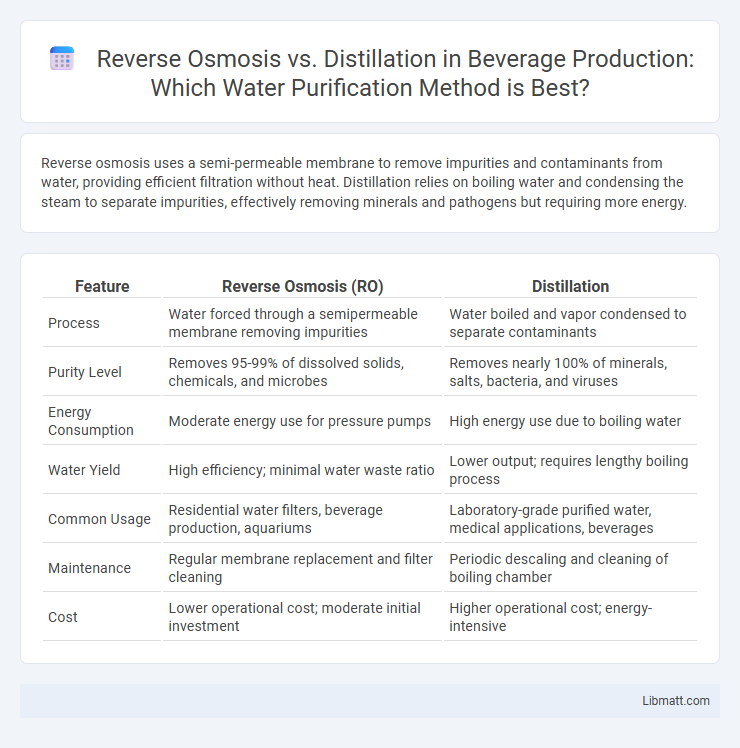Reverse osmosis uses a semi-permeable membrane to remove impurities and contaminants from water, providing efficient filtration without heat. Distillation relies on boiling water and condensing the steam to separate impurities, effectively removing minerals and pathogens but requiring more energy.
Table of Comparison
| Feature | Reverse Osmosis (RO) | Distillation |
|---|---|---|
| Process | Water forced through a semipermeable membrane removing impurities | Water boiled and vapor condensed to separate contaminants |
| Purity Level | Removes 95-99% of dissolved solids, chemicals, and microbes | Removes nearly 100% of minerals, salts, bacteria, and viruses |
| Energy Consumption | Moderate energy use for pressure pumps | High energy use due to boiling water |
| Water Yield | High efficiency; minimal water waste ratio | Lower output; requires lengthy boiling process |
| Common Usage | Residential water filters, beverage production, aquariums | Laboratory-grade purified water, medical applications, beverages |
| Maintenance | Regular membrane replacement and filter cleaning | Periodic descaling and cleaning of boiling chamber |
| Cost | Lower operational cost; moderate initial investment | Higher operational cost; energy-intensive |
Introduction to Water Purification Methods
Reverse osmosis and distillation are two effective water purification methods that remove contaminants by different processes; reverse osmosis forces water through a semi-permeable membrane to filter out impurities, while distillation heats water to create steam, leaving contaminants behind. Both methods significantly reduce harmful minerals, chemicals, and pathogens, ensuring safer and cleaner drinking water. Choosing your ideal purification technique depends on factors like water quality, energy consumption, and desired purity levels.
What is Reverse Osmosis?
Reverse osmosis is a water purification technology that uses a semipermeable membrane to remove ions, molecules, and larger particles from drinking water. It effectively eliminates contaminants such as salts, bacteria, and organic compounds, producing clean water with minimal chemical use. This process relies on pressure to push water through the membrane, separating impurities without requiring boiling or phase change like distillation.
Understanding Distillation Process
The distillation process separates impurities from water by heating it to create steam, which then condenses back into liquid form, leaving contaminants behind. This method effectively removes a wide range of dissolved solids, bacteria, and heavy metals by utilizing differences in boiling points. Understanding this process helps you determine if distillation suits your needs for producing highly purified water.
Key Differences between Reverse Osmosis and Distillation
Reverse osmosis uses a semipermeable membrane to remove impurities by applying pressure, effectively filtering out contaminants like salts, bacteria, and chemicals, while distillation relies on boiling water and condensing the steam to separate pure water from impurities based on boiling points. Reverse osmosis typically requires less energy and produces less waste compared to the energy-intensive distillation process, which can handle a wider range of contaminants including dissolved solids and volatile compounds. Your choice between reverse osmosis and distillation should consider factors such as water quality, energy efficiency, and specific purification needs.
Efficiency and Water Purity Comparison
Reverse osmosis offers higher efficiency by removing up to 99% of contaminants using less energy compared to distillation, which requires significant heat input. Both methods achieve high water purity, but reverse osmosis excels at filtering out dissolved salts, chemicals, and microorganisms, while distillation effectively eliminates pathogens and volatile compounds. Your choice depends on whether energy efficiency or the specific type of impurities in your water is the priority.
Energy Consumption: RO vs. Distillation
Reverse osmosis consumes significantly less energy than distillation, with typical RO systems requiring about 3 to 10 kWh per 1,000 gallons of purified water compared to distillation's 30 to 50 kWh for the same volume. The energy efficiency of RO comes from its membrane filtration process, which uses pressure rather than heat to separate impurities. Your choice between reverse osmosis and distillation should consider energy consumption alongside water quality needs and system maintenance.
Maintenance and Operational Costs
Reverse osmosis systems generally require regular filter and membrane replacements, making maintenance moderately frequent with operational costs depending on water quality and system size. Distillation units demand periodic cleaning to remove mineral buildup and higher energy consumption, resulting in increased operational expenses. Your choice between the two should consider the balance between maintenance efforts and ongoing energy or replacement costs for efficient long-term use.
Environmental Impact of Each Method
Reverse osmosis consumes less energy than distillation, making it a more environmentally friendly water purification method. Distillation requires significant heat input, often relying on fossil fuels, which increases carbon emissions and environmental footprint. Your choice between these methods can impact energy consumption and sustainability depending on your specific water treatment needs.
Suitability for Home and Industrial Use
Reverse osmosis offers efficient filtration for both home and industrial use, effectively removing impurities through a semipermeable membrane, making it suitable for drinking water purification and large-scale processes. Distillation, relying on evaporation and condensation, is ideal for industrial applications requiring high purity but is less practical for everyday home use due to energy consumption and slower output. Your choice depends on the required water quality, volume, and energy efficiency preferences.
Choosing the Right Method for Your Needs
Reverse osmosis effectively removes a wide range of contaminants including dissolved salts, bacteria, and heavy metals, making it suitable for everyday drinking water purification. Distillation excels at eliminating nearly all impurities by boiling and condensing water, ideal for laboratory or medical applications requiring ultra-pure water. Your choice depends on desired water quality, energy consumption, and maintenance preferences, with reverse osmosis offering convenience and distillation providing thorough purification.
Reverse osmosis vs distillation Infographic

 libmatt.com
libmatt.com